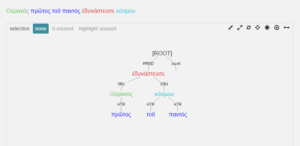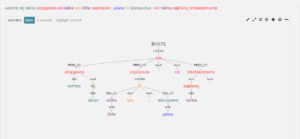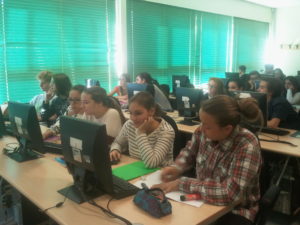Treebanking methodology has proven to be successful in the linguistic analysis of ancient Greek and Latin texts, and it has aroused a continuously increasing interest over the last few years. It is certainly one of the most exciting innovations in the field of Classics. Now it is time to see if it can also play a role in improving traditional education, leading didactics into the digital world.
In spring 2015, I was following a training in the Italian High School “Liceo Classico Socrate”, where I was allowed to lead a little experiment. The school has a solid tradition in Classical education, focused on Greek and Latin culture and language, so it was the ideal environment to test the potential impact of digital tools on the students’ learning process. The theoretical premise for this attempt was that the methodology of translating ancient Greek in Italian High School is similar to the process of dependency treebanking. The traditional method has a strong linguistic attitude: it requires complete analysis of the text divided into single sentences, according to a specific hierarchical structure, and the assignment of morphological and syntactic values to every single element according to traditional grammars. These tasks are performed with very limited use of the dictionary; then, a complete translation follows this established order, in order to ensure an easier conversion of the sentence into the new language. Treebanking seems to reproduce this process closely, but providing an alternative, aesthetically enjoyable and visually useful interface.
The experiment was performed with 22 students of 14 years of age, who were beginners in ancient Greek. These young cavies were involved in a four-days workshop of Ancient Greek Dependency Treebank, which took place in the School’s Informatics Lab. Their regular teacher was an additional and enthusiastic participant.
During the workshop, the students were introduced to basic notions of Natural Language Processing, dependency grammar, and to Arethusa, the platform chosen for the experiment. Then, they were divided into groups of two, and worked on short ancient Greek texts, at first according to their linguistic level: they treebanked two Aesopic fables taken from their schoolbook. Afterwards, I thought they could do something more, and assigned them the first chapter of Ps. Apollodorus’ Bibliotheca.
They performed a quite complete series of tasks, assigning morphological and syntactic values and treebanking each sentence. Being beginners, they almost had no clue in terms of translation, and were more or less forced to deep logical reasoning to solve problems, in order to understand how the language functions, and how it is structured to express things. It may sound as a dreadful, impossible task: in fact, the majority of students thinks so, and when they have to translate texts at home, first they run to the dictionary, sometimes with hilarious results. In this case, as the task assigned was different from the traditional translation, the students had to choose another method. They had the opportunity to concentrate on the “pure language”, without worrying about looking up in the dictionary. It was actually surprising for me to see how far they could go, even facing grammatical and syntactic structures that were not part of their school programme. At the same time, this was for me the demonstration that traditional learning methods are still possible, and that this generation of students is perfectly capable of following them: the only difference is that they were using a computer to do it.
The expression “digital natives” seems to scare teachers to death, just like these students were aliens trained to program in the cradle. Besides, it only means that computers are something naturally existing in their lives, something that they have been using everyday since they were born. Therefore, they are perfectly comfortable in using the machine for school tasks, provided that they are adequately trained to do it (actually, they did not learn to program in the cradle). My students were genuinely surprised to know that the Internet provided tools to perform their Greek homework, and the amount of positive effects it had on their performance was really interesting to inspect. In fact, they demonstrated extreme adaptability to the task: a surprisingly limited amount of time was dedicated to explain them how it worked, and they had no prejudices about its purposes, nor were ever complaining about the fact that they were not “translating”. In the final session, held after summer, I verified that they could perfectly remember the most important aspects of treebanking. In sum, the young beginners proved to be much more mentally flexible than many mature Classicists.
Treebanking on Arethusa enabled them to visualize their work on the spot, on a coloured and animated interface. It was not just abstract thinking about a text (which is one of the most annoying parts of translating): they could see the concrete effects of what they were doing, and even gain some satisfaction in looking at the completed trees. In addition, they had the opportunity to discuss what they were doing and to fearlessly propose their own interpretation; they made in-depth analysis of specific linguistic phenomena, also focusing on their school programme: for example, the usage of μέν and δέ, or the various types of Greek participles (which are universally considered as the average student’s nemesis). They made hypotheses, faced problems, debated. This trained them to independent reasoning, and the computer just made it more concrete and natural.
This is considered the most important educational effect of translating ancient texts: translating Greek and Latin is logical thinking. Although Classics have other important pedagogical advantages (or should do so), engaging with ancient texts is a fundamental part of this process. Translation is to establish an intimate and personal contact with the language, to understand how it expresses things, how it functions. More than anything, it gives everyone the possibility of giving his/her own interpretation, as long as it is reasonable. In short, it trains independent thought. Recent educational trends, aiming to reduce the role of translation and to use already translated texts, are leading to the loss of this important aspect – so it is no surprise that some detractors deny the role of Classics in educating scientific minds. Giving endless texts to translate as homework is not going to be the solution: it is frankly naïve to think that students will not immediately look for the translation on the Internet. If translation tasks were performed in a different way, let’s say, focusing on autonomous sentence-structure building, evaluating linguistic analysis, eventually inspecting proposals of translation (even from good authorial versions), maybe the process would not lose its educational potential, and would evaluate students’ thinking through the contact with the text. If I may add a personal consideration, it would be also more respectful of the “real language”, going beyond some popular nonsensical standardizations that modern grammars tend to present as reality.
Both my students and I gained something from the experience. I became convinced that this generation can perfectly adapt to new educational methods, and that this offers us a big occasion to innovate traditional didactics, especially in fields in increasing crisis like Classics. I am not suggesting that teachers should completely convert to digital tools and forget about traditional teaching. Au contraire: digital tools can help us to regain the advantages assessed by traditional methods. And we are going to lose important educational opportunities, if we refuse the change.
Treebanking in the classroom aroused a lot of interest and enthusiasm among the students. In the end, they defined it “a brilliant idea” for the study of ancient Greek.
Special thanks go to the Director of the School, Santa Ciriello, and to the teacher, Alessia Pitagora. And to the students, obviously.




